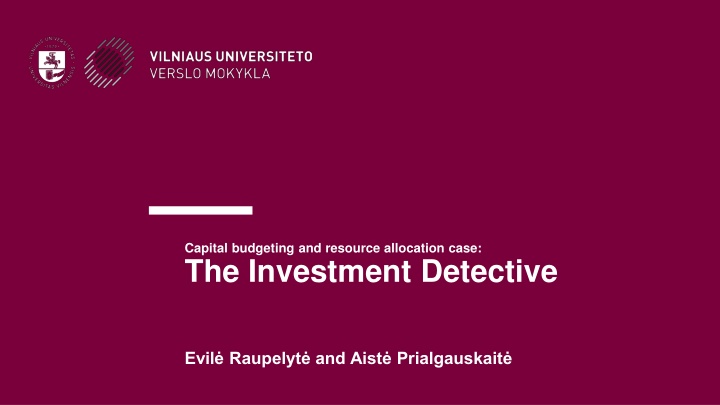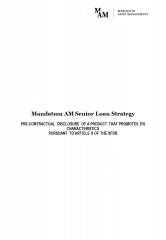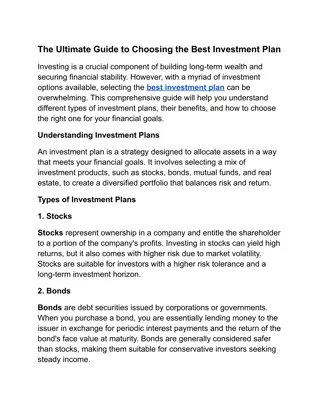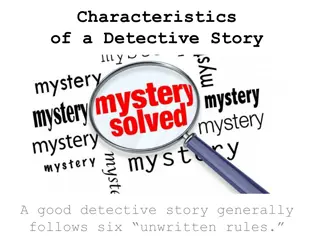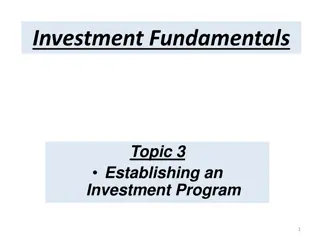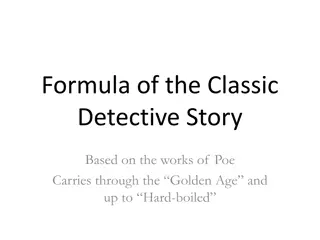The Investment Detective
Company evaluating 8 projects with a $2M initial investment. Tasks include ranking projects based on NPV, Payback Period, IRR, and Profitability Index. The qualitative ranking methods are discussed.
Download Presentation

Please find below an Image/Link to download the presentation.
The content on the website is provided AS IS for your information and personal use only. It may not be sold, licensed, or shared on other websites without obtaining consent from the author.If you encounter any issues during the download, it is possible that the publisher has removed the file from their server.
You are allowed to download the files provided on this website for personal or commercial use, subject to the condition that they are used lawfully. All files are the property of their respective owners.
The content on the website is provided AS IS for your information and personal use only. It may not be sold, licensed, or shared on other websites without obtaining consent from the author.
E N D
Presentation Transcript
Capital budgeting and resource allocation case: The Investment Detective Evil Raupelyt and Aist Prialgauskait
Introduction to the case: Company is considering investments in the 8 projects; The CEO has asked to rank the projects and recommend the 4 best the company should accept; Only the quantitative considerations are relevant; Projects 7th and 8th are mutually exclusive.
Introduction to the case: Initial investment: 2 million dollars; Projects are believed to be of the same risk class; The weighted average cost of capital has never been estimated; Appropriate discount rate: 10%.
Free cash flows of the project (numbers are calculated in thousands) Yellow parts of the table - indicate year on which the payback was accomplished
Tasks of the case study: 1. Can you rank the projects simply by inspecting the cash flows? We can evaluate the projects by just looking at the cash flows (that are shown below), but this isn't a reasonable way to do so.
2. What criteria might you use to rank the projects? Which quantitative ranking methods are better? Why? For the eight projects, we used the following tools to rate them in an entirely quantitative manner: 1.Net Present Value (NPV) 2. Payback Period and Discounted payback period 3. Internal Rate of Return (IRR) 4. Profitability Index (PI)
Ranking of the projects regarding NPV: In this case, we accepted all the projects, except the 2nd one, because it has a negative NPV value. The NPV approach has the drawback of not taking into account the length of the projects. Project 6 has a zero NPV, which is very weak, and selecting that project will be risky since we would not receive any financial gain.
Ranking of the projects regarding payback period and discounted payback period: The Discounted Payback approach is often preferable more than the Payback method.
Ranking of the projects regarding IRR: We rejected project 2, because its IRR is lower than the required return (10%) We consider excluding Project 6 because its IRR is equal to required return (10%)
Ranking of the projects regarding Profitability Index (PI): Based on our PI calculations, we rejected project 2, because its Profitability Index is lower than 1. Also we rejected Project 6 because its Profitability Index is equal to 1.
Key takeaways: The NPV method shows that projects 2 and 6 are not profitable. When there are many methods for selecting a project, it can be difficult to determine which is the best because investors usually want the best return on investment in the short term. NPV is the most common approach, and most experienced managers use it in practice, so we mostly relied on this tool. Because 7 and 8 projects are mutually exclusive, we selected project 8 with the higher NPV. Based on NPV approach, project 3 is the most valuable.
3. What is the ranking you found by using quantitative methods? Does this ranking differ from the ranking obtained by simple inspection of the cash flows?
Thank you for listening! Finance detectives: Aist and Evil
